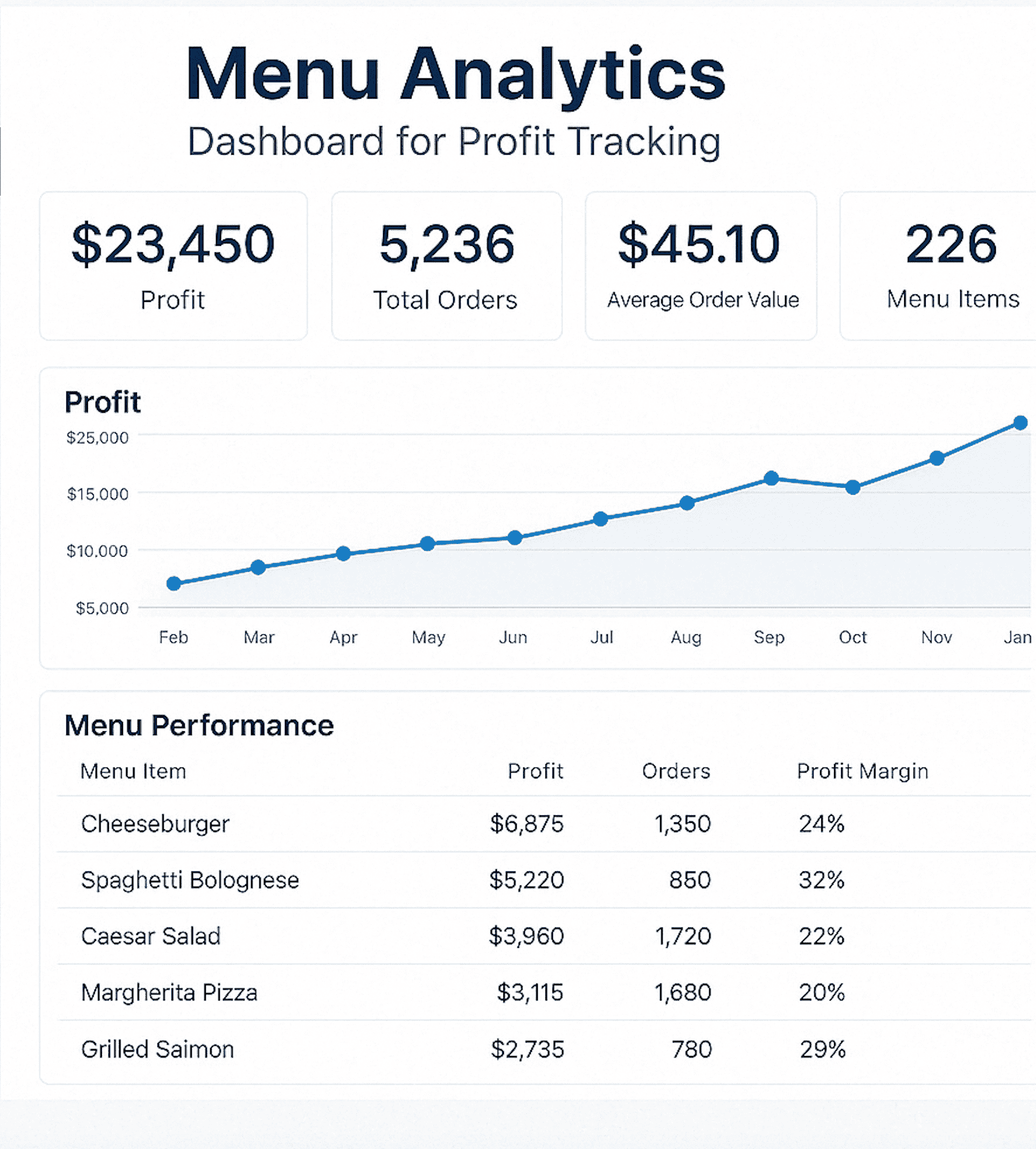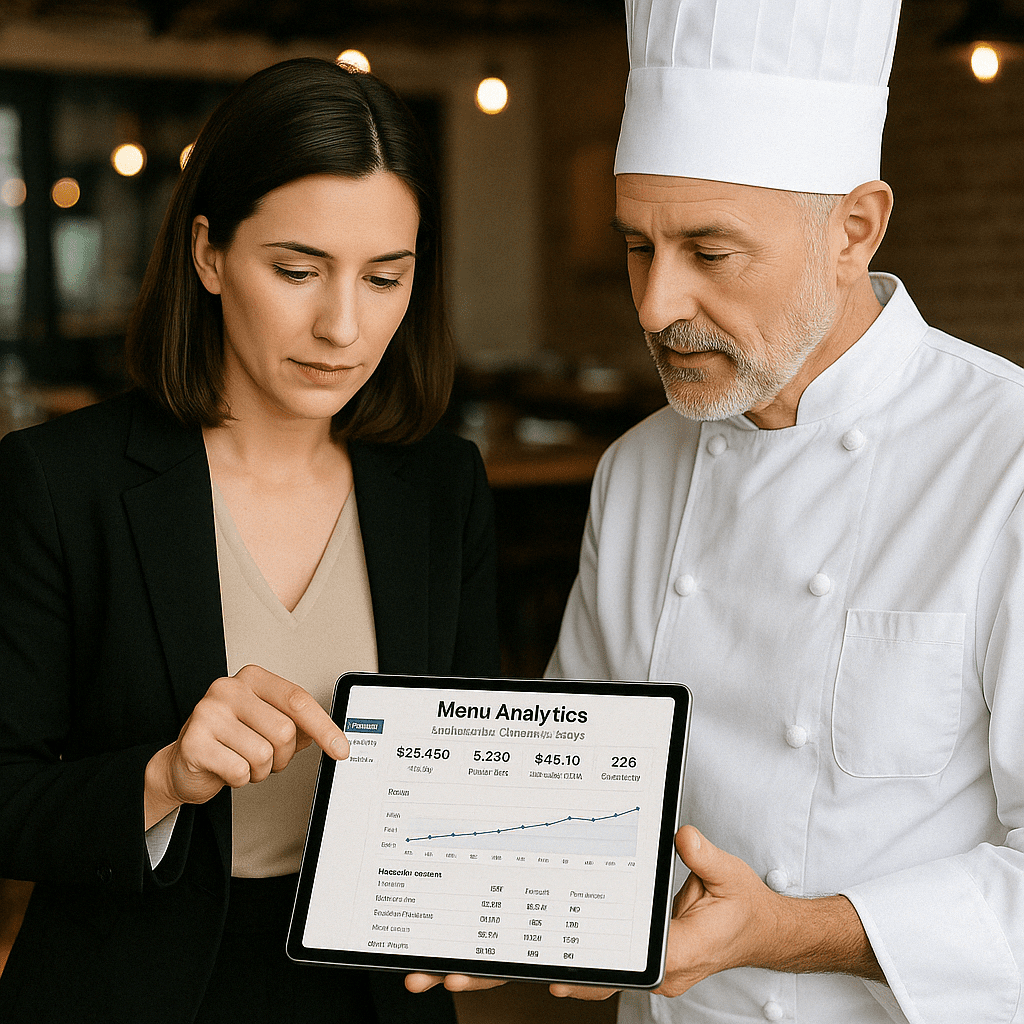In today’s competitive hospitality landscape, data-driven menu engineering has become essential for restaurants seeking to maximize profitability while satisfying evolving customer preferences. By leveraging analytics to strategically design, price, and position menu items, restaurants can significantly boost their bottom line in 2025 and beyond. At Socially Intrigued, our restaurant marketing specialists have developed proven methodologies that transform menu data into actionable profit strategies. Effective menu engineering restaurant profit strategies require systematic data analysis of item performance, pricing structures, and customer preferences.
Data-driven menu engineering boosting restaurant profit in 2025
The Evolution of Menu Engineering in 2025
Menu engineering has evolved from simple spreadsheet analysis to sophisticated AI-powered systems that continuously monitor performance metrics. According to Toast’s Restaurant Success Report, restaurants implementing data-driven menu strategies see an average 18% increase in profit margins compared to those using traditional approaches. Effective menu engineering restaurant profit strategies have evolved significantly in recent years.

The most successful restaurants now leverage:
- Real-time sales data analysis
- Customer preference tracking
- Ingredient cost fluctuation monitoring
- Competitive pricing intelligence
- Seasonal trend prediction
Four Pillars of Menu Engineering Restaurant Profit
1. Menu Item Profitability Analysis
The foundation of effective menu engineering begins with understanding the exact profitability of each dish. This requires precise calculation of:
- Food Cost Percentage: Track each ingredient’s contribution to overall dish cost
- Contribution Margin: Measure how much each item contributes to covering fixed costs
- Popularity Index: Monitor selling frequency against menu placement
Our clients at Socially Intrigued typically implement digital inventory systems that integrate with POS data to automatically calculate these metrics, eliminating the manual spreadsheet work that once dominated menu analysis.
2. Strategic Menu Design Based on Analytics
Once you understand profitability metrics, the next step is designing your menu to guide customer choices toward high-profit items. Research published in the Journal of Hospitality Management shows that strategic menu design can influence selection patterns by up to 27%.
Key design strategies include:
- Eye Movement Tracking: Position high-profit items where eye tracking studies show customers look first
- Psychological Pricing: Implement price anchoring techniques where premium items make standard options appear more valuable
- Description Optimization: Craft menu descriptions that trigger emotional responses, with studies showing that evocative descriptions can increase sales by up to 27%
3. Ingredient Cross-Utilization Analytics
Modern menu engineering leverages ingredient relationship mapping to identify opportunities for cross-utilization. This analysis reveals which ingredients can be shared across multiple menu items, reducing waste and lowering inventory costs.
For example, our client Highland Bistro implemented an ingredient mapping system that:
- Reduced ingredient SKUs by 22%
- Lowered food costs by 14%
- Decreased food waste by 31%
- Maintained menu diversity perception among customers
4. Dynamic Pricing Models
Static menu pricing is becoming obsolete in 2025. Leading restaurants now implement sophisticated dynamic pricing strategies similar to those used in the airline and hotel industries.
According to Restaurant Technology News, restaurants using dynamic pricing models report:
- 12% higher average checks during peak hours
- 23% increase in off-peak traffic through targeted promotions
- 8% overall revenue growth without significant cost increases
Implementing Menu Engineering Restaurant Profit Analysis
Step 1: Data Collection and Integration
Start by ensuring your restaurant has robust data collection systems in place:
- POS System Analytics: Choose a system that captures detailed item sales data, timing patterns, and server performance
- Inventory Management Software: Implement systems that track ingredient costs and usage in real-time
- Customer Feedback Integration: Collect and analyze customer feedback specifically related to menu items
- Competitor Price Monitoring: Use market intelligence tools to track pricing trends in your area
Step 2: Menu Item Classification
Using the collected data, classify each menu item according to the traditional menu engineering matrix:
- Stars: High profitability, high popularity (protect and promote)
- Puzzles: High profitability, low popularity (reposition or redesign)
- Plowhorses: Low profitability, high popularity (increase prices or reduce costs)
- Dogs: Low profitability, low popularity (remove or completely reimagine)
Modern menu engineering expands this model by incorporating:
- Customer retention impact
- Social media shareability
- Seasonal fluctuation patterns
- Supplier relationship dependencies
Step 3: Menu Design Optimization
With items properly classified, redesign your menu using data-driven principles:
- Place “Star” items in prime visual positions (typically top right of menu pages)
- Create visual emphasis around high-margin items through boxing, highlighting, or images
- Strategically position “puzzles” near popular items to increase their visibility
- Test different menu layouts using A/B testing methodology, measuring performance differences
Step 4: Continuous Performance Monitoring
Menu engineering is not a one-time project but an ongoing process:
- Establish weekly menu performance reviews analyzing profitability changes
- Implement quarterly menu revisions based on data insights
- Create seasonal specials that test new ingredients before full menu commitment
- Track performance metrics against established KPIs: contribution margin percentage, average check size, and item popularity
Case Study: Menu Engineering Restaurant Profit Success
One of our clients at Socially Intrigued, a mid-sized casual dining restaurant in Chicago, implemented our comprehensive menu engineering approach with remarkable results:
- 22% increase in overall profit margin within 4 months
- 14% reduction in food waste through improved ingredient cross-utilization
- 18% increase in average check size through strategic item placement and description optimization
- 26% boost in sales of previously underperforming high-profit items
The restaurant achieved these results while maintaining customer satisfaction scores, proving that data-driven decisions can align with customer preferences when properly implemented. When implementing menu engineering restaurant profit analysis, focus on both high-margin items and overall sales volume.
Advanced Analytics: The Future of Menu Engineering
AI-Powered Menu Prediction
In 2025, leading restaurants are implementing AI systems that can predict menu performance before items ever reach customers. These systems analyze:
- Historical sales patterns
- Current food trends from social media analysis
- Seasonal ingredient availability forecasts
- Weather prediction impact on dining choices
- Local event calendars influencing patronage
According to McKinsey’s Food Service Report, restaurants using predictive analytics for menu development see 31% fewer underperforming new items compared to those using traditional testing methods.
Customer Segmentation for Menu Customization
Advanced menu engineering now incorporates customer segmentation data to develop targeted menu strategies for different customer groups:
- Regular loyalty program customers
- First-time visitors
- Special occasion diners
- Business lunch clients
- Weekend family visitors
By analyzing the preferences and spending patterns of each segment, restaurants can customize digital menus, specials, and promotions to maximize relevance and profitability for each group.
Implementation Challenges and Solutions
While the benefits of data-driven menu engineering are clear, many restaurants face implementation challenges:
Challenge 1: Technology Integration
Solution: Start with a phased approach, beginning with basic POS analytics and gradually adding inventory management and customer feedback systems. Our restaurant technology guide provides a step-by-step implementation roadmap.
Challenge 2: Staff Training
Solution: Develop simple dashboards that translate complex data into actionable insights for managers and servers. Implement training programs that help staff understand how menu engineering impacts their role and potential earnings.
Challenge 3: Maintaining Culinary Creativity
Solution: Establish a balance between data-driven decisions and chef creativity by creating designated menu sections for innovative offerings alongside optimized staples. Monitor both profitability and customer response to maintain this balance.
Conclusion: The Competitive Advantage of Menu Engineering
In the increasingly competitive restaurant industry of 2025, data-driven menu engineering provides a significant advantage for establishments willing to invest in analytics. By transforming menu development from an art into a science-backed process, restaurants can simultaneously increase profitability while enhancing customer satisfaction. The ROI of menu engineering restaurant profit initiatives typically exceeds traditional marketing investments.
At Socially Intrigued, our restaurant marketing specialists help hospitality businesses implement these advanced menu engineering strategies with practical, measurable results. Our comprehensive approach integrates menu optimization with broader digital marketing strategies to ensure your restaurant thrives in today’s challenging market.
Ready to transform your menu into a profit-generating asset? Contact our team for a menu analysis and discover opportunities you may be missing in your current offerings.
This comprehensive guide to data-driven menu engineering was created by the team at Socially Intrigued, a premier digital and social media marketing agency specializing in restaurant and hospitality marketing solutions. For more information, visit sociallyintrigued.com.
Socially Intrigued Digital & Social Media Marketing Agency
NYC | L.A • 📧 [email protected] • 🌐 SociallyIntrigued.com

